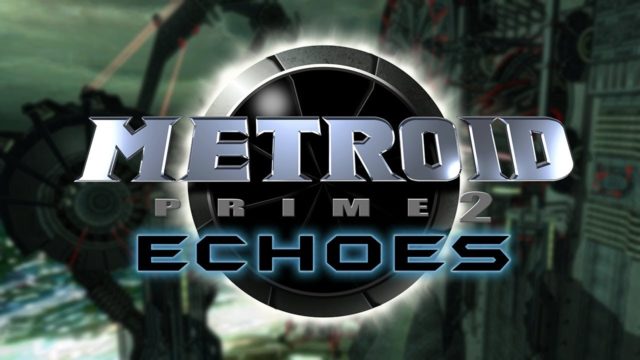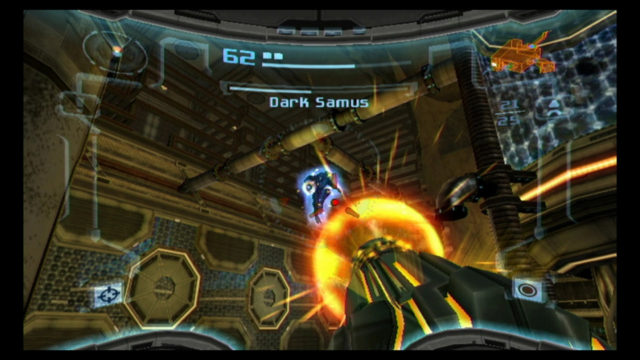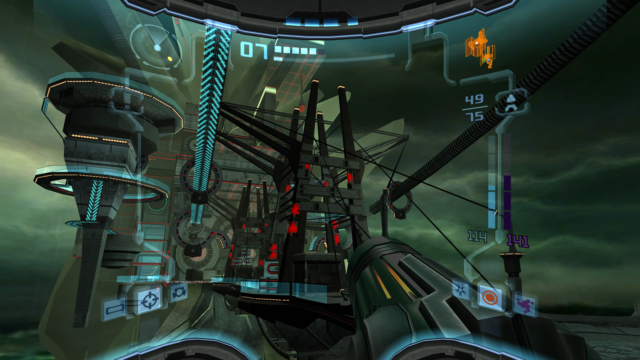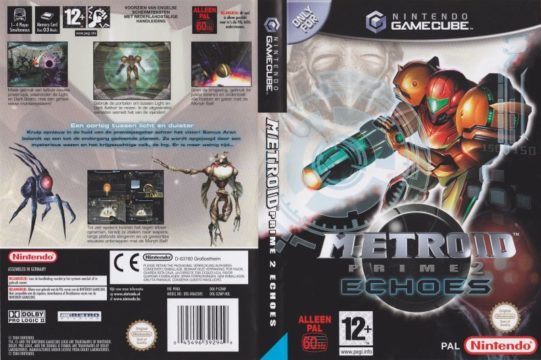
I’ve spent quite a bit of time going into how developer Retro Studios cultivated the atmosphere of dread found in Metroid Prime 2, but now I’d like to move on to some of the other changes and tweaks that this sequel brought to the table. For this section of our retrospective on Metroid Prime 2, I’ll be focusing on some of the more negative elements of the game, or things that just didn’t quite pan out the way that Retro Studios likely hoped that they would.
With that said, let’s look now at the story structure of Metroid Prime 2. The narrative is delivered quite differently here than it was in Metroid Prime. In that original installment, Samus explored the planet Tallon IV with very minimal prompting from her armor’s onboard artificial intelligence. Metroid Prime was arguably more focused on fostering an almost lackadaisical approach to player exploration versus constantly compelling them to move from one objective to the next. While it didn’t come near the virtually directionless catacomb roaming of Zebes in the first Metroid, Metroid Prime provided a perfect balance between the design sensibilities of NES-era game developers and contemporary fan expectations.
Metroid Prime 2 goes more in the opposite direction. It’s not a neck-breaking U-turn by any stretch of the imagination, but it’s clear that in this game Retro wanted the narrative to be front and center to a greater capacity. The primary change in Metroid Prime 2‘s story structure comes in the form of the Luminoth Sentinel U-Mos. With every temple that Samus restores, she must make a return trip to his location in the Great Temple and receive instructions as to where to travel next. It’s minimal guidance that’s no sin by Metroid standards— it’s nowhere near as intrusive here as it is in Metroid Fusion, for instance. I can understand why some fans might be turned off by the directions U-Mos provides, but ultimately players are as free to explore Aether and Dark Aether as they please once he’s said his piece. I wouldn’t necessarily label this as being a total negative, but it is divisive.
Speaking of the two Aethers, Nintendo is obviously no stranger to light and dark worlds. The Legend of Zelda: A Link to the Past and Twilight Princess are two ready examples of this mechanic, for instance. In Metroid Prime 2, Aether and Dark Aether are functionally similar to what fans have seen in other Nintendo titles, with the “dark” world offering a twisted take on the main “light” one, but it’s arguably not as well implemented here. It’s in this aspect of the game’s design that some of the cracks start to appear. The problem comes down to a handful of different factors relating to ease of navigation, world design, and tone.

Aether itself is a tad bit on the murky side when it comes to its visuals. The game world is a wash of muted browns, grays, blues, and greens that make the environment feel very genuine and realistic, but it’s not without its flaws. Some areas bleed into others, making it difficult to remember where to go when backtracking. The map helps, of course, but without as many distinct visual cues as its predecessor, Metroid Prime 2’s overworld can become a bit unwieldy to navigate. This is alleviated somewhat with the arrival of the more aesthetically unique Sanctuary Fortress and Sky Temple later in the game, but overall, it’s not as easy to get around Aether as it was Tallon IV.
This issue is exacerbated on Dark Aether. The color palette is slightly punched-up whenever Samus makes the shift to this version of the planet, but any benefits this would bring are offset by the general darkness found there. It can be hard to follow routes via the naked eye because of the abundance of shadows. Furthermore, Samus’ movement on Dark Aether is largely restricted for more than half the game to the small pools of light left behind by the Luminoth. The atmosphere on this planet is toxic, with the light offering Samus her only sanctuary from harm. It’s this constant damage that Dark Aether inflicts upon Samus that further inhibits navigation, as the player is forced to consider conserving health at all times while there. It can become distracting having to scrounge for light sources as opposed to just focusing on exploring.

Further compounding this dilemma is Metroid Prime 2‘s almost unbearable tone of dread. Now, this is something that will vary based on player tastes, but as pointed out earlier, Aether and Dark Aether are both relentlessly creepy. There are dead Galactic Federation and Luminoth soldiers everywhere. The Ing are hulking masses of sharp black edges and violently red, piercing eyes. Almost the entirety of the score is moody and atmospheric, heightening the tension every step of the way. It’s all a masterful example of how a developer can manufacture a very specific atmosphere in a game (and it’s a departure for Nintendo that I still applaud), but in Metroid Prime 2 it can sometimes feel like it’s working against the gameplay and not enhancing it. It’s easy to want to scour every inch of the two Aethers, but it can be tough when the player is sweating through their shirt in a panic while playing.
One of the other primary problems in Metroid Prime 2 revolves around its difficulty level. This is a shamelessly hard game. Foes that are already tenacious on Aether become even more so on Dark Aether. The bosses are some of the hardest to combat in the entire series. There is also an alarmingly low number of save stations in Metroid Prime 2. Forcing players to choose between expending time backtracking to save or bullishly moving ahead until reaching a new station comes across as a very cheap way of upping the challenge. It’s also a needlessly artificial amplifier considering the gameplay itself already provides all the difficulty anyone would ever need.

Speaking of artificial, the quest for the ten Sky Temple keys is wholly superficial and does nothing to enrich the game. Metroid Prime 2 would be a robust adventure without this gratuitous fetch quest. To be fair, it does compel further exploration of areas of the two planets that players might otherwise not return to, but the need for this incentive is dubious. Thorough players will always want to locate every last Missile and Energy Tank that a Metroid title has to offer, so it makes minimal sense to goad them into an action they’d likely take on their own, anyway. Like the confoundingly scarce Save Stations, the hunt for the Sky Temple keys is another synthetic attempt at augmenting Metroid Prime 2‘s gameplay that’s utterly unnecessary when the game already naturally provides all the challenge and incentive a player requires. In short, it’s overkill.
After having said all that, it might sound like Metroid Prime 2 is a royal mess of a game. Not true! Let’s head to the last section of this retrospective to take a gander at what this sequel does right!




 ShareThis
ShareThis





